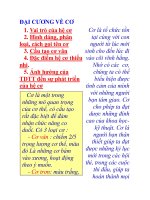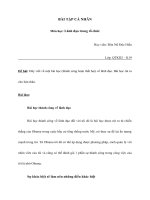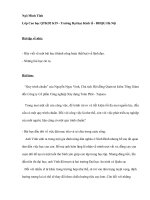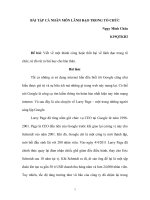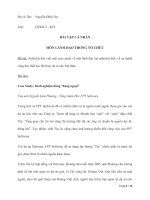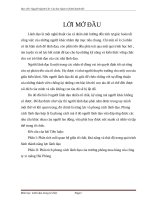Đại cương về lãnh đạo trong tổ chức chapter 10 leadership of culture, ethics
Bạn đang xem bản rút gọn của tài liệu. Xem và tải ngay bản đầy đủ của tài liệu tại đây (404.24 KB, 41 trang )
.c
om
an
co
ng
Chapter 10
cu
u
du
o
ng
th
Leadership of Culture,
Ethics, and Diversity
Copyright © 2010 by South-Western/Cengage Learning
All rights reserved.
CuuDuongThanCong.com
PowerPoint Presentation by Rhonda S. Palladi
Georgia State University
/>
.c
om
Culture
cu
u
du
o
ng
th
an
co
ng
Is the aggregate of beliefs, norms,
attitudes, values, assumptions, and ways
of doing things that is shared by
members of an organization and taught
to new members
Gives meaning to each individual’s
membership in the workplace and, in so
doing, defines the organization’s
essential purpose
Is recognized as a source of competitive
advantage
2
CuuDuongThanCong.com
/>
.c
om
The Power of Culture
du
o
ng
th
an
co
ng
A deeply rooted culture that is well matched to
strategy and external environmental trends is a
strong recipe for successful strategy execution
A weak or ―shallow-root‖ culture can become an
obstacle to successful strategy execution
Culture serves two important functions in
organizations:
cu
u
It creates internal unity
It helps the organization adapt to the external
environment
3
CuuDuongThanCong.com
/>
.c
om
The Power of Culture (cont.)
Internal unity
an
co
ng
Organizational culture defines a normative
order that serves as a source of consistent
behavior within the organization
cu
u
du
o
ng
th
– Provides organizational members with a way of
making sense of their daily lives
– Establishes guidelines and rules for how to behave
– Provides a system of informal rules and peer
pressures
– Provides a value system in which to operate
– Promotes strong employee identification with the
organization’s vision, mission, goals, and strategy
– Provides a shared understanding about the identity
4
of an organization
CuuDuongThanCong.com
/>
.c
om
The Power of Culture (cont.)
External adaptation
cu
u
du
o
ng
th
an
co
ng
Culture determines how the organization
responds to changes in its external
environment
The appropriate culture type can ensure that
an organization responds quickly to rapidly
changing customer needs or the offensive
actions of a competitor
5
CuuDuongThanCong.com
/>
.c
om
Low- and High-Performance Cultures
an
co
ng
The strength of any culture depends on
the degree to which a set of norms and
values are widely shared and strongly
held throughout the organization
cu
u
du
o
ng
th
A weak culture symbolizes a lack of
agreement on key values and norms
A strong culture symbolizes widespread
consensus
6
CuuDuongThanCong.com
/>
u
du
o
ng
th
an
co
ng
Insular thinking
Resistance to change
Politicized internal environment
Unhealthy promotion practices
cu
.c
om
Characteristics of
Low-Performance Cultures
7
CuuDuongThanCong.com
/>
.c
om
Characteristics of
High-Performance Cultures
Culture reinforcement tools
ng
th
an
co
ng
Ceremonies highlight dramatic examples of
what the company values, recognize and
celebrate high-performing employees, and
help create an emotional bond among all
employees
cu
u
du
o
Intensely people oriented
Results oriented
Emphasis on achievement and excellence
8
CuuDuongThanCong.com
/>
.c
om
The Role of Leadership in Culture
Creation and Sustainability
cu
u
du
o
ng
th
an
co
ng
Making sure an organization’s culture is
aligned with its strategies is among the
most challenging responsibilities of
leadership
To build and maintain a strong culture,
senior managers must have a clearly
defined vision, mission, and culture
statements that define the way things
are done
9
CuuDuongThanCong.com
/>
.c
om
Symbolic Leadership Actions
for Shaping Culture
cu
u
du
o
ng
th
an
co
ng
Leaders serving as role models
Celebrating achievements
Interacting face-to-face with rank-andfile
Matching organizational structure to
culture
Matching HR practices to culture
Matching operating policies and practices
to culture
Creating a strategy–culture fit
10
CuuDuongThanCong.com
/>
.c
om
Types of Organizational Cultures
ng
Degree of Environmental Turbulence
Competitive
Competitive
Culture
Culture
an
co
External
ng
th
Strategic
Focus
Bureaucratic
Bureaucratic
Culture
Culture
cu
u
du
o
Internal
Stable
Adaptive
Culture
Cooperative
Culture
Dynamic
Source: Based on M. D. Youngblood, “Winning Cultures for the New Economy,” Strategy and Leadership 28, 6
(Nov/Dec. 2000): 4–9; G. N. Chandler, C. Keller, and D. W. Lyon, “Unraveling the Determinants and Consequences
of an Innovative–Supportive Organizational Culture,” Entrepreneurship Theory and Practices 25, 1 (Fall 2000): 59–
76; J. R. Fisher, Jr. “Envisioning a Culture of Contribution,” Journal of Organizational Excellence 20, 1 (Winter
11
2000): 47–52.
CuuDuongThanCong.com
/>
.c
om
Cultural Value Types
Cooperative culture
cu
u
du
o
ng
th
an
co
ng
Represents a leadership belief in strong, mutually
reinforcing exchanges and linkages between
employees and departments
Operating policies, procedures, standards, and tasks
are all designed to encourage cooperation, teamwork,
power sharing, and camaraderie among employees
Management thinking is predicated on the belief that
organizational success is influenced more by employee
relationships inside the organization than by external
relationships
Employees are trained to think like owners rather than
hired hands
12
CuuDuongThanCong.com
/>
.c
om
Cultural Value Types (cont.)
Adaptive culture
cu
u
du
o
ng
th
an
co
ng
Represents a leadership belief in active monitoring of
the external environment for emerging opportunities
and threats
Made up of policies, procedures, and practices that
support employees’ ability to respond quickly to
changing environmental conditions
Members are encouraged to take risks, experiment,
and innovate
Management thinking is based on the belief that
organizational success is influenced more by events
outside the organization than by internal factors
Employees are empowered to make decisions and act
quickly to take advantage of emerging opportunities or
13
avoid threats
CuuDuongThanCong.com
/>
.c
om
Cultural Value Types (cont.)
Competitive culture
cu
u
du
o
ng
th
an
co
ng
Represents a leadership that encourages and values a
highly competitive work environment
Organizational policies, procedures, work practices,
rules, and tasks are all designed to foster both internal
competition and external competition
Leaders focus on the achievement of specific targets
such as market share, revenue, growth, or profitability
Values competitiveness, personal initiative,
aggressiveness, achievement, and the willingness to
work long and hard for yourself or for the team
14
CuuDuongThanCong.com
/>
.c
om
Cultural Value Types (cont.)
Bureaucratic culture
cu
u
du
o
ng
th
an
co
ng
Represents a leadership that values order,
stability, status, and efficiency
Leaders perceive their environments as
basically stable with an internal strategic
focus
Emphasizes strict adherence to set rules,
policies, and procedures
Are highly structured and efficiency driven
15
CuuDuongThanCong.com
/>
.c
om
How to Sustain an
Organization’s Culture
cu
u
du
o
ng
th
an
co
ng
Define a strategic plan for implementing
the company culture
Use well-trained and experienced
employees to train new hires
Make sure that employees at all levels
know what the culture is and accept it
Institute a system by which new
employees learn the written and
unwritten parameters of the culture
16
CuuDuongThanCong.com
/>
.c
om
Values-Based Leadership
cu
u
du
o
ng
th
an
co
ng
Values are generalized beliefs and
behaviors that are considered by an
individual or group to be important
A leader’s decisions and actions reflect
his or her personal values and beliefs
Integrity and strong values are vital
traits of good leaders
Values-based leadership is about courage
and character
17
CuuDuongThanCong.com
/>
.c
om
Values-Based Leadership (cont.)
du
o
ng
th
an
co
ng
How leaders’ ethical values influence
follower behavior and performance is the
subject of values-based leadership
The leader’s values and behaviors are
significantly related to the values and
behaviors of subordinates
cu
u
Followers take their cue from the leader
18
CuuDuongThanCong.com
/>
.c
om
The Leader’s Role in
Advocating Ethical Standards
du
o
ng
th
an
co
Codes of ethics
Ethics committees
Training programs
Disclosure mechanisms
u
Whistle blowing
cu
ng
Some of the tools available for leaders to
use in enforcing ethical behavior include:
19
CuuDuongThanCong.com
/>
.c
om
National Culture Identities—Hofstede’s
Value Dimensions
cu
u
du
o
ng
th
an
co
ng
A nation’s values and norms determine what
kinds of attitudes and behaviors are acceptable
or appropriate
The people of a particular culture are socialized
into national values as they grow up
Norms and social guidelines prescribe how
members of a nation should behave toward each
other
Significant differences between national cultures
exist and make a difference in how leaders and
employees behave in organizations
20
CuuDuongThanCong.com
/>
High
Power
Distance
co
High
Uncertainty
Avoidance
Long-term
Orientation
Masculinity
Short-term
Orientation
Femininity
u
Low
Uncertainty
Avoidance
cu
Collectivism
du
o
ng
th
an
Individualism
ng
.c
om
A Framework of Value Dimensions for
Understanding Cultural Differences
Low
Power
Distance
Source: Based on G. Hofstede, “Cultural Constraints in Management Theories,” Academy of Management
Executive (1993), pp. 81–94.
21
CuuDuongThanCong.com
/>
.c
om
Individualistic to Collectivist Cultures
ng
Individualism is a psychological state in which people see
themselves first as individuals and believe their own
interest and values are primary
co
Examples:
th
an
– United States
– Great Britain
– Canada
cu
Examples:
u
du
o
ng
Collectivism is the state of mind wherein the values and
goals of the group—whether extended family, ethnic
group, or company—are primary
– Greece
– Japan
– Mexico
22
CuuDuongThanCong.com
/>
.c
om
High to Low Uncertainty
Avoidance Cultures
co
ng
A society with high uncertainty avoidance contains a
majority of people who do not tolerate risk, avoid the
unknown, and are comfortable when the future is
relatively predictable and certain
th
ng
– United States
– Australia
– Canada
an
Examples:
cu
u
du
o
A society where the majority of the people have low
uncertainty avoidance has people who are comfortable
with and accepting the unknown, and tolerate risk and
unpredictability
Examples:
– Italy
– Japan
– Israel
23
CuuDuongThanCong.com
/>
.c
om
High to Low
Power-Distance Cultures
ng
In a high power-distance culture, leaders and
followers rarely interact as equals
th
an
Mexico
Spain
Japan
France
ng
–
–
–
–
co
Examples:
cu
u
du
o
In a low power-distance culture, leaders and
their members interact on several levels as
equals
Examples:
– Germany
– United States
– Ireland
CuuDuongThanCong.com
24
/>
.c
om
Long-Term to Short-Term
Oriented Cultures
an
co
ng
People from a culture with a long-term
orientation have a future-oriented view of life
and thus are thrifty and persistent in achieving
goals
th
Examples:
ng
– Most Asian countries
u
du
o
A short-term orientation derives from values
that express a concern for maintaining personal
happiness and living for the present
cu
Examples:
– Most European countries
– United States
25
CuuDuongThanCong.com
/>
